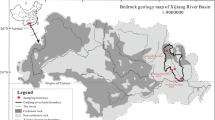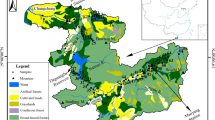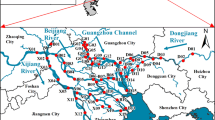Abstract
In order to explore the change process and law of carbon sinks flux in the middle and upper reaches of the Xijiang River basin, the research workers discuss the influencing factors of carbon sinks flux in the study area under natural process and impact of human activity. The hydrologic station at Wuzhou was taken as the research object. River water was sampled and measured regularly from April 2011 to March 2012 three times per month (intensive measurements and sampling were carried out during the heavy rainfall period), and then river water samples were analyzed. The following results are shown: (1) The chemistry of water revealed that the middle and upper reaches of the Xijiang River basin comprised the HCO3 −Ca type; in total anions, both HCO3 − and Ca2+ comprised 69 % and 75.9 %, respectively, as a result of carbonate rock weathering. (2) The content of NO3 − and SO4 2− was high, which might be the result of human activities, such as agriculture and industry. Moreover, sulphuric acid is involved in dissolution of carbonate minerals, and missing sink that is caused by exogenous acid is indispensable. (3) The annual total carbon flux was 6664.45 × 106 kg CO2; the carbon flux in flood season and non-flood season accounted for 58.25 and 41.75 % of carbon sinks of karst water, respectively. Correspondingly, the intensity of carbon sinks was 1694.48 and 1214.53 kg/mon km2, respectively. (4) Discharge was the primary factor of the intensity of carbon sinks and carbon flux; other influential factors, such as inorganic carbon and biological pump, had less influence on the intensity of carbon sinks and carbon flux. These conclusions are theoretically important and practically significant for estimating the carbon sink in Xijiang basin accurately. This study is a scientific basis for exploiting and protecting water resources.








Similar content being viewed by others
References
Cao JH, Yang H, Kang Z (2011) Preliminary regional estimation of carbon sink flux by carbonate rock corrosion: a case study of the Pearl River Basin. Chin Sci Bull 56(35):3766–3773
Cassar N, Laws EA, Bidigare RR et al. (2004) Bicarbonate uptake by southern ocean phytoplankton. Global Biogeochem Cycles 18(2). doi:10.1029/2003GB002116
Dean WE, Gorham E (1998) Magnitude and significance of carbon burial in lakes, reservoirs, and peatlands. Geology 26:535–538
Drysdale R, Lucas S, Carthew K (2003) The influence of diurnal temperatures on the hydrochemistry of a tufa depositing stream. Hydrol Process 17:3421–3441
Dupré B, Dessert C et al (2003) Rivers chemical weathering and Earth’s climate. Comptes Rendus Geosci 335(16):1141–1160
Gaillardet J, Dupré B, Louvat P et al (1999) Global silicate weathering and CO2 consumption rates deduced from the chemistry of large rivers. Chem Geol 159:3–30
Gao QZ, Shen C (1998) River carbon flux and continental erosion. Adv Earth Sci 13(4):369–375 (In Chinese)
Gao QZ, Shen C, Sun Y (2001) Chemical weathering in Zhujiang. River drainage 30(3):223–230 (In Chinese)
Gibbs R (1970) Mechanisms controlling world water chemistry—evaporation-crystallization process. Science 170:1088–1090
Han GL, Liu C (2001) Hydrogeochemistry of Wujiang River water in Guizhou province China. Chin J Geochem 20(2):240–248
Han GL, Liu C (2004) Water geochemistry controlled by carbonate dissolution: a study of the river waters draining karst-dominated terrain, Guizhou Province, China. Chem Geol 204:1–21
Han GL, Liu C (2005) Hydrogeochemistry of rivers in Guizhou Province, China: constraints on weathering in karst terrain. Adv Earth Sci 20(4):394–406 (In Chinese)
He SY (1996) Field study methods in karst geochemistry and some examples. Carsologica Sinica 15(1–2):200–206 (In Chinese)
He SY, Xu SY, Zhang M (1997) Observation on soil CO2 concentration, hydrochemistry, and their relationship with karst processes. Carsologica Sinica 16(4):319–324 (In Chinese)
Hu Y, Jiang Y, Li L (2011) Preliminary study on short-time carbon absorption in epikarst spring basin—a case of the Shuifang Spring in Jinfo Mountain, Chongqing. Carsologica Sinica 30(2):169–174
Huang J, Liu P, Qin X (2011) The characteristics of karst carbon sink in the Guijiang catchment. Carsologica Sinica 30(4):437–442 (In Chinese)
Jiang YJ, Hu Y, Schirmer M (2013) Biogeochemical controls on daily cycling of hydrochemistry and δ13 C of dissolved inorganic carbon in a karst spring-fed pool. J Hydrol 478:157–168
Lal R (2008) Carbon sequestration. Phil Trans R Soc B 363:815–830
Liu ZH (1990) Necessities of measuring pH in site in the study of karst hydrogeochemistry. Carsologica Sinica 9(4):310–317 (In Chinese)
Liu ZH (2012a) New progress and prospects in the study of rock-weathering-related carbon sinks. Chin Sci Bull 57(2–3):95–102 (In Chinese)
Liu ZH (2012b) Recent advance and prospect of carbon sink caused by rock weathering. Chin Sci Bull 57(2–3):95–102
Liu ZH, Dreybrodt W (2012) Comparison of carbon sequestration capacity between carbonate weathering and forests: the necessity to change traditional ideas and methods of study of carbon sinks. Carsologica Sinicas 31(4):345–348
Liu Y, Liu Z (2010) Experimental study on the utilization of DIC by Oocystis solitaria Wittr and its influence on the precipitation of calcium carbonate in karst and non-karst waters. Carbonates Evaporites 25(1):21–26
Liu Z, Li Q, Wang J (2004) Ground water resource assessment under the conditions to control ground subsidence—a case study in Shanghai city. Carsologica Sinica 23(3):169–176 (In Chinese)
Liu ZH, Dreybrodt W, Wang H (2007) An important CO2 sink may be generated by global hydrological cycle. Chin Sci Bull 52:2418–2422 (In Chinese)
Liu C, Jiang Y, Tao F (2008) Chemical weathering of carbonate rocks by sulfuric acid and the carbon cycling in Southwest China. Geochimica 04:404–414 (In Chinese)
Liu ZH, Dreybrodt W, Liu H (2011) Atmospheric CO2 sink: silicate weathering or carbonate weathering. Quat Sci 31:426–430 (In Chinese)
Lü B, Liu Z, Liao C (2006) The influence of aquatic plants variation of hydrochemistry in Karst dynamic system—a case in the Guilin Karst experimental site. Carsologica Sinica 25(4):335–340 (In Chinese)
Maier-Peimer E (1993) The biological pump in the greenhouse. Glob Planet Change 8:13–15
Melnikov NB, O’Neill BC (2006) Learning about the carbon cycle from global budget data. Geophys Res Lett 33:L02705. doi:10.1029/2005GL023935
Nimick DA, Gammons CH, Parker SR (2011) Diel biogeochemical processes and their effect on the aqueous chemistry of streams: a review. Chem Geol 283(1–2):3–17
Raymond PA (2003) Cole JJ (2003) Increase in the Export of Alkalinity from North America’s Largest River. Science 301:88–91
Sundquist ET (1993) The global carbon dioxide budget. Science 259:934–941
Tang WK, Tao Z, Gao QZ (2014) Biogeochemical processes of the major ions and dissolved inorganic carbon in the Guijiang river. Environ Sci 35(6):2099–2107
Tans PP, Fung IY, Takahashi T (1990) Observational constraints on the global atmospheric CO2 budget. Science 247:1431–1438
Tao Z, Gao QZ, Wang ZG et al (2011) Estimation of carbon sinks in chemical weathering in a humid subtropical mountainous basin. Chinese Sci Bull 56:3774–3782
The Compilation Committee (1991) The history of Zhujiang. Guangzhou: Guangdong Science and Technology Press, 150 pp (In Chinese)
The Compilation Committee of Zhaoping County (1992) The history of Zhaoping County. Nanning: Guangxi People’s Publishing House pp 87–88 (In Chinese)
Watson RT, Meria Filho LG, Sanhueza E et al (1992) The supplementary report to the IPCC scientific assessment (in climate change). Cambridge Press, Cambridge, pp 29–46
Wu WH, Zheng HB, Yang JD et al (2012) Review and advancements of studies on silicate weathering and the global carbon cycle. Geol J China universities 18(2):215–224 (In Chinese)
Yao G, Gao Q (2005) The feedback and response of the riverine carbon cycle to global changes. Progress Geography 24(5):50–60 (In Chinese)
Yao G, Gao Q, Wang Z (2008) Seasonal and spatial variations of dissolved inorganic carbon in the lower reaches of the Xijiang River and its export flux. Geochimica 37(3):258–264 (In Chinese)
Yu S, He S, Yang H (2012) Research on carbon source effect of acid rain in a typical carbonate rock area,Guangxi. Earth Environ 40(1):44–49 (In Chinese)
Yuan DX, Zhu D, Weng J (1994) Karstology in China. Beijing: Beijing Geological Press, 207 pp (In Chinese)
Zhang C (2011) Time-scale of karst processes and the carbon sink stability. Carsologica Sinica 30(4):368–371 (In Chinese)
Acknowledgments
This work was supported by the National Natural Science Foundation of China (41202185), the Project of the China Geological Survey (12120113005100), the Project of Natural Science Foundation of Guangxi (2014GXNSFBA118228) and Project of Institute of karst geology, CAGS (201320, 201429).
Author information
Authors and Affiliations
Corresponding author
Rights and permissions
About this article
Cite this article
Yu, S., Du, W., Sun, P. et al. Study on the hydrochemistry character and carbon sink in the middle and upper reaches of the Xijiang River basin, China. Environ Earth Sci 74, 997–1005 (2015). https://doi.org/10.1007/s12665-014-3771-y
Received:
Accepted:
Published:
Issue Date:
DOI: https://doi.org/10.1007/s12665-014-3771-y




